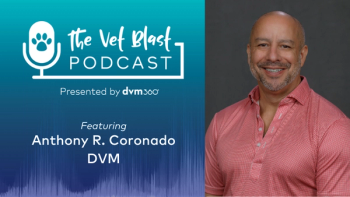
Rising from the ashes
A firsthand look at the Woolsey and Hill fires in Southern California, and the veterinary heroes who helped save all creatures great and small from its damage.
A relative of dvm360 financial analyst Christopher Holston snapped these pictures of burning buildings from his vehicle as he evacuated his home in Paradise, California, with his two dogs. Credit: Dennis Holston.With sustained Santa Ana winds blowing through land marked by chaparral and dry vegetation, the Woolsey Fire spread from Los Angeles County rapidly into Ventura County on Thursday, Nov. 8, charring more than 70,000 acres in its first day. Within a few hours that same day, the Hill Fire broke out in the rural agricultural area of the Santa Rosa Valley in Ventura County.
Both wildfires unleashed a wave of mandatory evacuation orders as they grew in size and destruction. Apocalyptic images of residents and their animals fleeing from the fast-moving wall of flames soon dominated the headlines in media outlets from coast to coast.
On Friday, acting Gov. Gavin Newsom declared a state of emergency for Los Angeles and Ventura counties. Three days later, President Trump issued a major disaster declaration for the state, releasing federal resources to combat the two blazes that by then had burned more than 100,000 acres.
As one of six evacuation centers designated for large and small animals when natural disasters strike, Pierce College-a community college that includes a veterinary technology program in Woodland Hills, California-became ground zero for fire-related veterinary care. Public- and private-private veterinary professionals came together from across Los Angeles to treat animals affected by the disaster.
Donated food and supplies await distribution by the LA Department of Animal Care and Control. Photo courtesy of Brandon Black.Caring for those in need
Maria Sabio-Solacito, DVM, chief of staff from the Los Angeles County Department of Animal Care and Control (DACC), is in command of animal care response across the sprawling 426-acre Pierce campus, which also houses an equestrian center. As the fires blazed, Dr. Sabio-Solacito scrambled to get enough resources and experienced personnel out to her location.
“Whenever we go into emergency response, we try to make sure the animals being evacuated are free from injuries,” Dr. Sabio-Solacito says.
Dr. Sabio-Solacito put out a call to the Southern California Veterinary Medical Association (SCVMA) pleading for help from veterinarians and RVTs, posting her message and contact details to Twitter and other social media outlets. The response from across the nation was overwhelming.
“I was getting texts and phone calls from as far away as Washington, western Pennsylvania, Hawaii and New Hampshire,” says Dr. Sabio-Solacito. “I put out a call for help to the veterinary community because I needed trained people who could come in and be comfortable handling emergencies and not be overwhelmed or panicked.”
One source of help was Veterinary Angels, a medical center in Agoura Hills that was evacuated at 2 a.m. on the second day of the Woolsey Fire. Veterinary Angels provided staff and much-needed resources to both DACC and the Red Cross.
“When we're working with LA County Animal Control we want to provide as much medical and clinical care as possible,” says Darlenne Geekie, RVT, director of Veterinary Angels.
DACC and Veterinary Angels used a M.A.S.H.-style tent as a makeshift triage center to treat animals with burns and lacerations. “We would triage the animals on the spot,” Dr. Sabio-Solacito says. Some animals were stabilized in crates for a few hours before being transferred to a hospital.
If animals were brought in exhibiting signs of smoke inhalation, Dr. Sabio-Solacito and her team put them in an oxygen cage or oxygen tent to facilitate clean oxygen intake. When they came in with burns, the team took measures to ensure the animals were at minimal risk of infection.
“We clip out the burnt area, making sure it's free of debris, and try to clean as much of the area as possible,” Dr. Sabio-Solacito says. “You also want to cool down the affected area so you don't have progressive injuries developing in that area and deeper into the tissue.”
The triage tent was open from 8 a.m. until 6 p.m., but medical staff stayed on the clock until midnight so they could respond to urgent cases after hours. Veterinarians and veterinary nurses from DACC also made trips inside the Red Cross shelter, which allowed co-housing of small pets with their owners, to check on the welfare of the animals. Moving among the population of evacuees, the team inspected kennels to make sure the animals had enough blankets, were adequately clean and weren't exhibiting signs of stress.
“The support that we provide isn't just for the animals,” says Dr. Sabio-Solacito. “It's also for the owners.”
Geekie concurs. “The most important element is that human-animal bond, and it's making people feel safe and secure,” she says.
Bringing normalcy to an environment that was anything but normal, Dr. Sabio-Solacito and her team took care of routine checkups, nail trims, ear cleanings and even offered to walk evacuees' pets.
A dog receives treatment for burns from the team coordinated by the Los Angeles Department of Animal Care and Control. Photo courtesy of the Little Angels Project.All creatures and their caretakers
Horses evacuated during the wildfires in Los Angeles County received treatment and shelter at the equestrian center at Pierce College, one of six evacuation centers designated for large and small animals when natural disasters strike in the region. Photo courtesy of Natalie Miranda.During the first few days, the equestrian center at Pierce College was inundated with evacuated animals. Its 115 stables filled to capacity within 24 hours of both fires breaking out. Emergency responders built temporary pens while many evacuees slept in their trucks with their horses and other large animals tied to the trailer.
During the peak of the evacuations, the center was handling upwards of 280 animals. While most were horses, evacuees also brought in miniature horses, ponies, cows, donkeys, goats, sheep, alpacas, chickens, turtles and a rabbit.
Larger animals that sustained burns or lacerations were treated at the equestrian center similarly to their smaller counterparts. Wounds were cleaned and treated with medication and close monitoring. Systemic antibiotics and pain medication were incorporated into the care each animal received.
Calabasas resident Trish Costa was evacuated in the waking hours of the second day of the Woolsey Fire. With her three horses and two ponies in tow, she arrived at Pierce College to a chaotic scene she described as “surreal,” with scores of evacuees trying desperately to find shelter for their animals. Costa slept in her F-150 with her animals tied to the trailer. She ended up waiting nearly 30 hours to secure open stalls for her horses and ponies.
Another evacuee, Alexa Stiles, evacuated from Agoura Hills around the same time as Costa with 19 horses in two trailers. “Within an hour we went from not being too afraid to going into disaster mode to get the horses out,” she recalls. “The top of the pasture was already burning by the time we got out of there.”
Stiles, like Costa, tied up all 19 horses to the cattle trailer upon arriving at the equestrian center and slept in her truck while awaiting shelter for the horses. Eventually, two spacious sand paddocks were given to accommodate the horses as their home away from home.
Handling the influx of horses and other large animals from evacuation zones is the purview of LA County's Equine Response Team (ERT). The all-volunteer group works with the DACC during natural disasters and emergencies and took charge of managing the equine center's shelters and barns where horses and other large animals would temporarily live.
ASPCA Los Angeles was also heavily involved, deploying a disaster response team to assist in the health and well-being of horses and other animals evacuated to Pierce College and other triage centers along with their owners.
Recalling her first weekend of handling Woolsey Fire evacuees and the barrage of animals that made their way to Pierce College, Tina Reddington of ASPCA Los Angeles says, “It was so busy and with so many emotions with people upset. Knowing that the animals were being cared for by animal lovers and were in good hands I think gave owners a lot of relief during this hectic situation.”
The priority for ASPCA is for the animals to be treated well. According to Reddington, who is the volunteer program director and designated shelter manager at Pierce College, ASPCA is focused on ensuring “that the animals are receiving the love and attention they need and that their daily needs are met.”
On Nov. 12, the Woolsey Fire was burning across canyons and valleys in Ventura and Los Angeles counties. More than 250,000 residents and their animals had been evacuated from Thousand Oaks, Oak Park, Agoura Hills and Calabasas.
Early that day ASPCA volunteers dropped off two alpacas from the Agoura Hills area at the equestrian center. Both alpacas had sustained burns. The county's ERT team called in an equine specialist to more accurately assess the two animals.
“There's the damage you can see and then there's the damage you can't see,“ explains David Ramey, DVM, an equine veterinarian who is on call during emergencies and states of natural disaster to assist the DACC.
The pair of alpacas uncharacteristically did not try to flee and were receptive to being handled while in the stall with Dr. Ramey during his assessment. Because of this, Dr. Ramey knew the animals were in a state of distress.
Over the course of 24 hours, the female alpaca responded well to antibiotics and began eating. But in that same 24 hours, the male “went from looking like something to be concerned about to dying,” says Dr. Ramey. “He wasn't burned other than a few superficial spots. But the prolonged exposure to intense heat was detrimental.”
A cat receives oxygen therapy at the triage tent at Pierce College for small pets affected by the fires. Photo courtesy of the Little Angels project.Building from ashes
As of Nov. 19, the Woolsey Fire continued to burn, its path of destruction spanning more than 98,000 acres across Los Angeles and Ventura counties. According to California fire officials, the fire is nearing 100 percent containment.
The Hill Fire was extinguished within a week of its initial outbreak but left behind 4,500 scorched acres in Ventura County. In the fire's wake, hundreds of homes and properties have been reduced to ash and rubble. Stables have been burned to the ground. The number of deaths and missing people are still being counted.
But through all the chaos and turmoil, the veterinary partnerships from the public and private sectors made the difference. Veterinary professionals responded around the clock to a surge of need by evacuees and their beloved animals.
“It's a collective effort. No one person or agency will be able to handle disasters like this on their own,” says Dr. Sabio-Solacito.
Echoing these comments, Geekie says, “I've been impressed by everyone who has stepped forward, from doctors and RVTs who have come to help, to reps and hospitals who have given us supplies and people who have given monetary donations.”
“The response of the private sector wanting to help gives me a lot of hope for us as a community and as a country,” says Dr. Sabio-Solacito. “We can still come together and work together and be united.”
Brandon Black is a Los Angeles-based writer whose work has appeared in regional and national publications. Like a typical Californian, he is passionate about traveling and making adventures for himself and his girlfriend. Dogs have been part of his life since he was in the third grade and he has a real soft spot for two in particular, Bailey and Growler.
Newsletter
From exam room tips to practice management insights, get trusted veterinary news delivered straight to your inbox—subscribe to dvm360.





